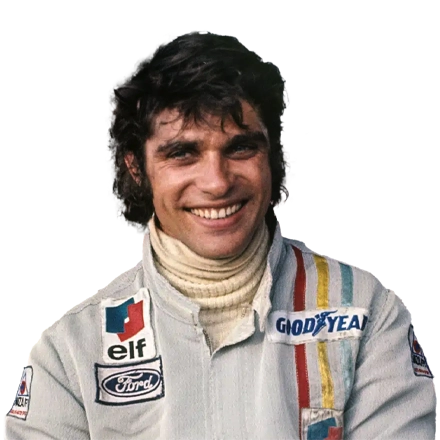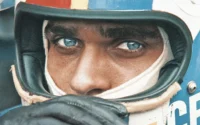François Cevert was a French racing driver whose brief but dazzling Formula One career made him one of the sport’s most beloved figures. Competing from 1969 to 1973, Cevert was the charismatic, fiercely talented protégé of Jackie Stewart and the pride of the Tyrrell team. His crowning moment came at the 1971 United States Grand Prix, where he claimed his first, and tragically, only, F1 Grand Prix victory.
| Nationality | French |
|---|---|
| Born | Albert François Cevert 25 February 1944 Paris, Nazi-occupied France |
| Died | 6 October 1973 (aged 29) Watkins Glen, New York, U.S. |
François Cevert was born into a Parisian family with a remarkable story of resilience. His father, Charles Goldenberg (1901–1985), was a Russian-Jewish jeweller who had fled Tsarist persecution as a child. During World War II, Charles joined the French Resistance to avoid deportation under Nazi occupation. To protect the family, he registered his four children under their mother’s surname, Cevert, a name that would later become legendary in racing circles. After the war, Charles offered to restore their true family name, but the children had already embraced “Cevert” as their own.
François’ sister Huguette later married another French racing star, Jean-Pierre Beltoise, making motorsport something of a family affair.
The Road to F1
Cevert’s love affair with speed began in his teens, not on four wheels, but two. At sixteen, he raced his mother’s Vespa against friends around Paris before upgrading to a Norton motorcycle at nineteen. After completing his national service, he set his sights on a career in car racing. In 1966, he trained at the Le Mans school before enrolling at the Winfield Racing School in Magny-Cours. There, he won the prestigious Volant Shell scholarship, earning a factory Alpine Formula Three car as his prize.
His first season in Formula 3 was a lesson in struggle; limited funds and experience resulted in poor performance. But Cevert refused to fade. With new sponsorship in 1968 and a switch to a more competitive Tecno, he began to dominate the field. That season, he became French Formula 3 Champion, narrowly beating future F1 star Jean-Pierre Jabouille.
Climbing the Ladder: Formula Two
Cevert’s F3 success earned him a seat with Tecno’s works Formula Two team in 1969. Competing against some of the sport’s best, he finished third overall and made his Formula One debut in the F2 class at the 1969 German Grand Prix. At a Crystal Palace race that year, Jackie Stewart found himself struggling to pass the young Frenchman, an encounter that would change Cevert’s life. Stewart urged Tyrrell team boss Ken Tyrrell to “keep an eye on him.” When Tyrrell needed a new driver the following year, Stewart’s recommendation carried the day. As Tyrrell later said, “Everyone thought it was Elf who pushed for him—but really, it was Jackie.”
The Formula One Years
When Johnny Servoz-Gavin abruptly retired just three races into the 1970 season, Tyrrell promoted Cevert to partner the reigning World Champion. Cevert debuted at Zandvoort in a March-Ford, improving rapidly with each race and earning his first championship point at Monza.
In 1971, Tyrrell began building its own cars, and the team hit its stride. Cevert finished second in France and Germany, both times shadowing Stewart. But it was the season finale at Watkins Glen that sealed his legacy. Starting fifth, Cevert surged past Stewart on lap 14 and held off Jacky Ickx until the Ferrari’s gearbox gave way. Despite sliding on spilt oil and clipping the barriers, Cevert recovered to take the checkered flag, arms raised, both hands off the wheel in jubilation. He became only the second Frenchman ever to win a Formula One Grand Prix, joining Maurice Trintignant in the F1 history books, and collected a $50,000 prize for his win. That season, he finished third in the 1971 Drivers’ Championship behind Stewart and Ronnie Peterson.
Momentum and Maturity
The 1972 season proved more challenging. Tyrrell struggled for consistency, and Cevert scored just three points finishes, two seconds (Belgium and the United States) and a fourth at his home race in France. Yet there were bright spots: he finished runner-up at the 24 Hours of Le Mans, sharing a Matra-Simca 670 with Howden Ganley.
By 1973, Tyrrell was back on form. Cevert, now polished and confident, was regularly matching Stewart’s pace. He finished second six times that year, three of those directly behind Stewart. The two shared a bond of mutual respect, though Cevert’s rising speed made it clear he was ready to lead. Stewart privately planned to retire at the end of the season, paving the way for Cevert to become Tyrrell’s new number one driver in 1974.
The Crash at Watkins Glen
Tragically, that passing of the torch would never happen. During Saturday morning qualifying on 6 October for the 1973 United States Grand Prix, Cevert was pushing hard for pole position when disaster struck. In the high-speed “Esses,” his Tyrrell 006 clipped the kerb on the left, skated across the track, and hit the right-hand barrier. The impact sent the car careening back into the opposite guardrail, almost head-on at over 150 mph. The barriers tore through the car, killing Cevert instantly.
Jackie Stewart, one of the first to reach the scene, later recalled: “They left him there because it was so clear he was gone.” The paddock fell silent as word spread. Lotus boss Colin Chapman reportedly murmured, “Cevert… bloody hell,” while Ronnie Peterson, Cevert’s close friend, was left visibly shaken. The Tyrrell team withdrew immediately. Stewart, who had already clinched his third title, chose not to start what would have been his 100th and final race.
François Cevert was just 29 years old.
Legacy and Lessons
Stewart later analysed the crash and concluded that a difference in driving style may have contributed. He preferred to take the Esses in fourth gear—lower revs, more stability. Cevert attacked it in third, keeping the engine on the boil but making the car twitchier through the uneven section. The short-wheelbase Tyrrell was notoriously jumpy there, and a minor error could prove fatal.
A chilling documentary filmed that very morning shows Stewart and Cevert debating the ideal gear choice through the Esses, moments before the crash. Cevert’s death, and the eerily similar fatal accident of Helmuth Koinigg a year later at the same circuit, prompted major safety changes. In 1975, a chicane was installed to slow cars through that section, a direct response to those tragedies.
François Cevert now rests in the cemetery of Vaudelnay, in Maine-et-Loire, a life cut short, but one that burned brightly enough to leave a permanent mark on Formula One. Handsome, fearless, and impossibly quick, Cevert was the golden boy who could have been France’s first World Champion, and whose legend remains frozen forever at Watkins Glen.
Francois Cevert’s Formula One World Championship Career
| Active years | 1969–1973 |
|---|---|
| Teams | Tecno, Tyrrell |
| Entries | 48 (47 starts) |
| Championships | 0 |
| Wins | 1 |
| Podiums | 13 |
| Career points | 89 |
| Pole positions | 0 |
| Fastest laps | 2 |
| First entry | 1969 German Grand Prix |
| First win | 1971 United States Grand Prix |
| Last win | 1971 United States Grand Prix |
| Last entry | 1973 United States Grand Prix |
Francois Cevert Teammates
| 4 drivers | Involvement | First Year | Last Year |
|---|---|---|---|
| Jackie Stewart | 47 | 1970 | 1973 |
| Peter Revson | 1 | 1971 | |
| Patrick Depailler | 2 | 1972 | |
| Chris Amon | 2 | 1973 |
Francois Cevert Complete Formula One Results
| Year | Entrant | Chassis | Engine | 1 | 2 | 3 | 4 | 5 | 6 | 7 | 8 | 9 | 10 | 11 | 12 | 13 | 14 | 15 | WDC | Points |
|---|---|---|---|---|---|---|---|---|---|---|---|---|---|---|---|---|---|---|---|---|
| 1969 | Tecno Racing Team | Tecno TF69 | Ford L4 | RSA | ESP | MON | NED | FRA | GBR | GER Ret | ITA | CAN | USA | MEX | NC ‡ | 0 ‡ | ||||
| 1970 | Tyrrell Racing Organisation | March 701 | Ford V8 | RSA | ESP | MON | BEL | NED Ret | FRA 11 | GBR 7 | GER 7 | AUT Ret | ITA 6 | CAN 9 | USA Ret | MEX Ret | 22nd | 1 | ||
| 1971 | Elf Team Tyrrell | Tyrrell 002 | Ford V8 | RSA Ret | ESP 7 | MON Ret | NED Ret | FRA 2 | GBR 10 | GER 2 | AUT Ret | ITA 3 | CAN 6 | USA 1 | 3rd | 26 | ||||
| 1972 | Elf Team Tyrrell | Tyrrell 002 | Ford V8 | ARG Ret | RSA 9 | ESP Ret | MON NC | BEL 2 | FRA 4 | GBR Ret | GER 10 | AUT 9 | ITA Ret | 6th | 15 | |||||
| Tyrrell 006 | Ford V8 | CAN Ret | USA 2 | |||||||||||||||||
| 1973 | Elf Team Tyrrell | Tyrrell 006 | Ford V8 | ARG 2 | BRA 10 | ESP 2 | BEL 2 | MON 4 | SWE 3 | FRA 2 | GBR 5 | NED 2 | GER 2 | AUT Ret | ITA 5 | CAN Ret | USA DNS | 4th | 47 | |
| Tyrrell 005 | Ford V8 | RSA NC |





